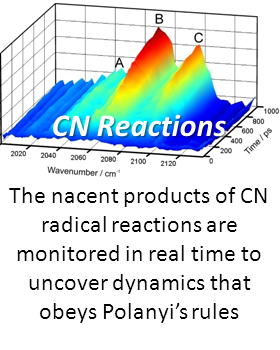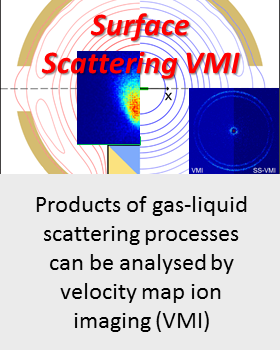
Research
| SJG Home |
| SJG Research |
| CD3 Scattering |
| CN reactions |
| Cl trajectories |
| H+D2 QCT |
| SJG Publications |
| |
| |
| Chemical Dynamics Home |
| Research Themes |
| People |
| Jobs |
| Links |
Last updated September 2025 |
 The mechanisms of the experimentally investigated atom + molecule reactions are also examined theoretically, using Quasi-Classical trajectories both on-the-fly and on ab initio potential energy surfaces. The mechanisms of the experimentally investigated atom + molecule reactions are also examined theoretically, using Quasi-Classical trajectories both on-the-fly and on ab initio potential energy surfaces.
|
|
The Theoretical Study of Reaction Mechanisms
The mechanisms of a variety of atom + molecule reactions are studied using Quasi-Classical trajectories on ab initio potential energy surfaces and by velocity map imaging experiments. Reaction systems currently under study are listed below.
Tug-of-War inelastic collisions in the H + D2 reaction
This work has been carried out with
Eckart Wrede and in collaboration with the group of
Richard N. Zare and their
reaction dynamics experiment.
Trajectory movies of this molecular tug-of-war which can be seen here.
This work has been published in the journal Nature:
"Vibrational excitation through tug-of-war inelastic collisions."
S. J. Greaves, E. Wrede, N. T. Goldberg, J. Zhang, D. J. Miller, R. N. Zare,
Nature, 454 88–91, 3 July 2008.
See also the press release on the University of Bristol home page, here and the story on the School of Chemistry news site.
Further analysis of the tug-of-war mechanism in the hydrogen exchange reaction was presented at the recent
dynamics of molecular collisions meeting (DMC) in Snowbird, UT.
The poster presented can be found here (1.7MB).
New, unexpected, and dominant reactive mechanisms in the hydrogen exchange reaction
This work was carried out with Eckart Wrede and published in the Journal of Chemical Physics here with a companion paper here . The supporting website, with animated examples of the trajectories can be found here.
-
Vibrational excitation through tug-of-war inelastic collisions.
Nature, 454 88–91, (2008).
-
New, unexpected, and dominant mechanisms in the hydrogen exchange reaction
J. Chem. Phys., 128 164306 (2008).
-
A quasiclassical trajectory study of the time-delayed forward scattering in the hydrogen exchange reaction
J. Chem. Phys., 128 164307, (2008).
Investigating chattering in the Cl + alkane reactions
This work, carried out in conjunction with Diego Troya, utilized the on-the-fly trajectory methodology along with a specific-reaction-parameters AM1 Hamiltonian to explore the mechanism of hydrogen abstraction in th title reaction. The intital results of this work have been published in the journal Chemical Physics Letters here, as well as a more comprehensive article in the Journal of Physical Chemistry A; doi:10.1021/jp802347v .
-
Quasi-classical trajectory study of the dynamics of the Cl + CH4 → HCl + CH3 reaction
Phys. Chem. Chem. Phys., 13 11438–11445, (2011).
doi: 10.1039/C0CP02694H
-
Classical trajectory study of the dynamics of the reaction of Cl atoms with ethane,
J. Phys. Chem. A, 112 9387 (2008).
-
Studying 'chattering collisions' in the Cl + ethane reaction with classical trajectories,
Chem. Phys. Lett., 441 171 - 175 (2007).
Cavity ring down spectroscopy
Cavity ring down spectroscopy, a highly sensitive direct absorption technique, has been used to study the torsional motions of a prototypical molecular wire cooled in a molecular beam. This work has been published in J. Phys. Chem. A.
Details of the experimental setup can be found here, with a summary of the results here.
-
Cavity Ring-Down Spectroscopy of the Torsional Motions of 1,4-Bis(phenylethynyl)benzene.
J. Phys. Chem. A, 110 2114–2121, (2006).




